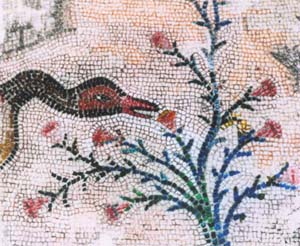Sima Meir | Yesusum*
Curator: Dalia Levin
July 5, 2003 - Oct. 18, 2003

Yesusum, 2003, painting in Artline marker on old Formica kitchen cupboard doors
The series Yesusum* [Rejoice] features mosaic paintings extracted from photographs of sixth century mosaic floors uncovered in archaeological excavations in Israel, from Tiberias, through Beth She’an, Zippori (Sepphoris) and Beth Alpha to Ma’on (Nirim).
The mosaics are rendered in felt-tip pens and Artline markers on a variety of old kitchen cupboard doors found throughout the artist’s kibbutz. The doors became available due to a gradual upgrading of the private kitchens in the members’ apartments as part of the process of ‘bourgeoization’ undergone by kibbutzim in Israel.